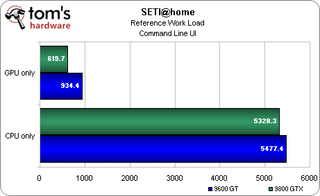CUDA-Enabled Apps: Measuring Mainstream GPU Performance
SETI@home Results
If you thought video conversion was time-intensive, wait until you look for aliens. Simply processing a single 373K file with a modern dual-core CPU took me nearly an hour and a half, a source:transcode time ratio of approximately 1:50. By default, the SETI@home benchmark only throws one work unit at a processor. With a dual-core chip, each core handles 50% of the load; with a quad-core, expect 25 percent. However, we want to see full utilization, so using the command benchcpu.bat 2 throws two instances at the processor, filling both cores.
You’ll notice that the CPU-only score on the 9800 GTX config is slightly lower than on the 9600 GT. This is merely within the statistical margin of variance. Additional runs show numbers that, averaged out, put the results about even.
There are two important take-aways here. First, check out the incredible runtime benefit CUDA delivers over CPU-only processing, requiring only 17% of the work time on a 9600 GT and only 11% of the time on a 9800 GTX. Consider how many years it typically takes to see such application performance leaps through CPU evolution alone.

Second, we clearly see the benefit of those extra stream processors in the 9800 GTX at play here. The 9800 GTX turns in a 50% superior performance over its cousin in the GPU-only tests. For $20, that’s one heck of a boost.
Since this was a synthetic benchmark, we weren’t as concerned about tracking CPU utilization during the GPU tests. If you’re curious, running our SETI@home tests on the CPU resulted, of course, in 100% use. The GPU test kept the CPU running around 50% to 60% utilization.
If you’d rather pursue disease cures than alien civilizations, we recommend running Folding@home. If you want to benchmark Folding@home, Nvidia recommends starting with the new OpenMM tool available right here.

As a fan of science and technology, I feel bound to point out that the SETI@home effort is under imminent threat of closure. The Arecibo radio telescope, the world’s largest single-dish telescope, is located in Puerto Rico and has been the source of all the data processed by the SETI@home project since 1999. Arecibo is run by Cornell University and receives funding from several sources, both public and private. Unfortunately, though, budget shortfalls have led the National Science Foundation to declare that Arecibo will close in 2011, possibly taking SETI@home offline with it, unless funding improves.
Stay on the Cutting Edge
Join the experts who read Tom's Hardware for the inside track on enthusiast PC tech news — and have for over 25 years. We'll send breaking news and in-depth reviews of CPUs, GPUs, AI, maker hardware and more straight to your inbox.
-
SpadeM The 8800GS or with the new name 9600GSO goes for 60$ and delivers 96 stream processors. Would it be correct to assume that it would perform betwen the 9600 GT and 9800 GTX you reviewed?Reply
Other then that great article, been waiting for it since we got a sneak preview from Chris last week. -
curnel_D And I'll never take Nvidia marketing seriously until they either stop singing about CUDA being the holy grail of computing, or this changes: "Aside from Folding@home and SETI@home, every single application on Nvidia’s consumer CUDA list involves video editing and/or transcoding."Reply -
As more software will use CUDA, we will not only see a great boost in performance for e.g. video performance, but for parallel programing in general. This sky rocket this business into a new age!Reply
-
curnel_D l0bd0nAs more software will use CUDA, we will not only see a great boost in performance for e.g. video performance, but for parallel programing in general. This sky rocket this business into a new age!Honestly, I dont think a proprietary language will do this. If anything, it's likely to be GPGPU's in general, run by Open Computing Language.(OpenCL)Reply -
IzzyCraft Who knows it's just a clip he used he could be naming it anything for the hell of it.Reply
CUDA transcoding is very nice to someone that does H.264 transcoding at a high profile and lacks a 300+ dollar cpu who would spend hours transcoding a dvd on high profile settings.
Else from that CUDA acceleration has just been more of a feature nothing like a main event. Although can easly be the main attraction to someone that does a good flow of H.264 trasncoding/encoding.
Encoding/transcoding in h.264 high profile can easily make someone who is very content with their cpu and it's power become sad very quickly when they see the est time for their 30 min clip or something. -
I'm using CoreAVC since support was added for CUDA h264 decoding. I kinda feel stupid for buying a high end CPU (at the time) since playing all videos, no matter the resolution or bit-rate, leaves the CPU at near-idle usage.Reply
Vid card: 8600GTS
CPU: E6700 -
IzzyCraft Well you lucked in considering not all of the geforce 8 series supports H.264 decoding etc.Reply -
ohim they should remove Adobe CS4 suite from there since Cuda transcoding is only posible with nvidia CX videocards not with normal gaming cards wich supports cuda.Reply -
adbat CUDA means Miracle in my language :-) I it will do thoseReply
The sad thing is that ATI does not truly compete in CUDA department and there is not standard for it.
Most Popular

